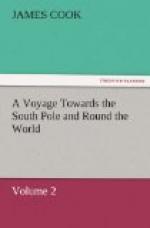When I consider the vast quantity of ice we saw, and the vicinity of the places to the Pole where it is formed, and where the degrees of longitude are very small, I am led to believe that these ice-cliffs extend a good way into the sea, in some parts, especially in such as are sheltered from the violence of the winds. It may even be doubted if ever the wind is violent in the very high latitudes. And that the sea will freeze over, or the snow that falls upon it, which amounts to the same thing, we have instances in the northern hemisphere. The Baltic, the Gulph of St Laurence, the Straits of Belle-Isle, and many other equally large seas, are frequently frozen over in winter. Nor is this at all extraordinary, for we have found the degree of cold at the surface of the sea, even in summer, to be two degrees below the freezing point; consequently nothing kept it from freezing but the salt it contains, and the agitation of its surface. Whenever this last ceaseth in winter, when the frost is set in, and there comes a fall of snow, it will freeze on the surface as it falls, and in a few days, or perhaps in one night, form such a sheet of ice as will not be easily broken up. Thus a foundation will be laid for it to accumulate to any thickness by falls of snow, without its being at all necessary for the sea-water to freeze. It may be by this means these vast floats of low ice we find in the spring of the year are formed, and which, after they break up, are carried by the currents to the north. For, from all the observations I have been able to make, the currents every where, in the high latitudes, set to the north, or to the N.E. or N.W.; but we have very seldom found them considerable.
If this imperfect account of the formation of these extraordinary floating islands of ice, which is written wholly from my own observations, does not convey some useful hints to an abler pen, it will, however, convey some idea of the lands where they are formed: Lands doomed by Nature to perpetual frigidness; never to feel the warmth of the sun’s rays; whose horrible and savage aspect I have not words to describe. Such are the lands we have discovered; what then may we expect those to be which lie still farther to the south? For we may reasonably suppose that we have seen the best, as lying most to the north. If any one should have resolution and perseverance to clear up this point by proceeding farther than I have done, I shall not envy him the honour of the discovery; but I will be bold to say, that the world will not be benefited by it.
I had, at this time, some thoughts of revisiting the place where the French discovery is said to lie. But then I considered that, if they had really made this discovery, the end would be as fully answered as if I had done it myself. We know it can only be an island; and if we may judge from the degree of cold we found in that latitude, it cannot be a fertile one. Besides, this would have kept me two months longer at sea, and in a tempestuous latitude,




